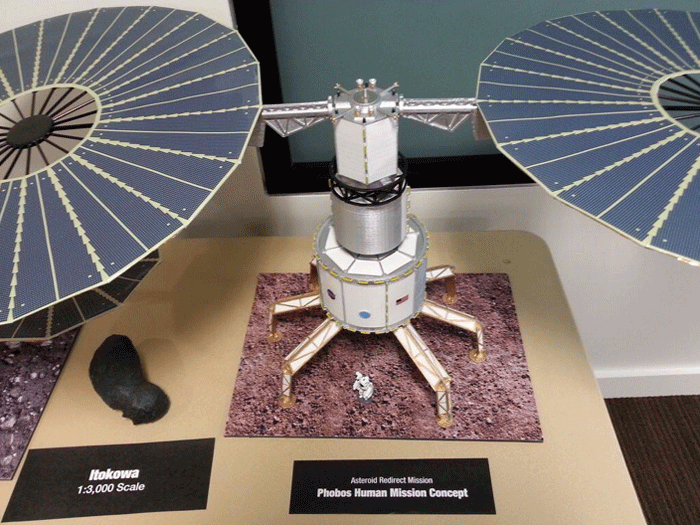.

Ahead of Congressional Hearing, NASA Floats Phobos Pit Stop on Road to Mars
.
With debate over NASA’s long-term strategy for sending humans to Mars set to continue this week in a June 25 hearing of the House Science Committee, NASA scored an opportunistic first word here June 23 with a soft-launch of a new intermediate destination on the long road to the red planet: the martian moon Phobos.
In a meeting of the NASA Advisory Council’s Human Exploration and Operations Committee, Jason Crusan, director of the Advanced Exploration Systems Division at NASA headquarters here, said getting astronauts to Mars sometime in the 2030s could involve a pit stop at the planet’s largest moon Phobos — a staging area where NASA could leverage both the technology and the lessons learned from the Asteroid Redirect Mission that would culminate with a crewed launch to a small space rock in a lunar storage orbit by 2025. The asteroid astronauts would ride in the Orion crew capsule and be launched by the heavy-lift Space Launch System.
“The moons of Mars pose a significant advantage as a waypoint on the way to the surface of Mars,” Crusan said. “If we choose to go through Phobos on our way to the surface of Mars, that environment of interacting with the asteroid will be nearly the same environment as interacting with Phobos.”
William Gerstenmaier, NASA associate administrator for human exploration and operations, clarified later on in the meeting that among Mars’ moons, NASA considers only Phobos a potential waypoint for human explorers. The smaller martian moon Deimos, Gerstenmaier said, has been ruled out.
During the meeting, NASA had on display a series of model spacecraft, including a Phobos exploration vehicle that resembled a scaled-up version of one of the two uncrewed asteroid retrieval spacecraft concepts the agency will choose between later this year for the first stage of the Asteroid Redirect Mission — which will robotically retrieve an asteroid between five and 10 meters in diameter and hauling it back to the distant lunar retrograde orbit where astronauts would later visit it to take samples.
The Phobos exploration vehicle, Crusan said, could take advantage of some, if not all, of the technology NASA is developing for the robotic asteroid retrieval craft, including a bulked up version of the high-power solar arrays the agency will use for the uncrewed leg of the asteroid retrieval mission. Operationally, however, the asteroid retrieval mission is a “direct analogue” for rendezvousing with Phobos, Crusan told the committee.
Crusan said a spider-like Phobos crew vehicle could be “tucked in” to the stony martian moon, which is roughly 22 kilometers in diameter and orbits only about 6,000 kilometers from the planet’s surface. That would provide Mars-bound astronauts with a radiation-shielded staging ground for descent to the planet’s surface.
The Phobos pit stop is only one of the elements of the strategy NASA trotted out for the NASA Advisory Council’s human spaceflight committee June 23. Crusan and Gerstenmaier also spoke of putting mini-space stations, comprising a Mars transfer habitat and pressurized crew vessel that could also be used for a Phobos-Mars astronaut taxi, in the same distant lunar retrograde orbit NASA’s eyeying for the Asteroid Retrieval Mission.
The strategy outlined by Crusan and Gerstenmaier depends on technology and systems not yet a part of NASA’s budget.
However, NASA’s strategy appears to satisfy one demand that House lawmakers made in a NASA Authorization (H.R. 4412) bill now awaiting consideration by the Senate Commerce, Science and Transportation Committee: explaining where the Asteroid Redirect Mission fits in a road map to Mars.
A road map to Mars is one of the key deliverables NASA will have to make to Congress should H.R. 4412 — which the House passed June 9 — become law. Even Democratic lawmakers on the House Science Committee are cautious about the Asteroid Retrieval Mission and have declined to endorse it wholeheartedly until NASA shows how the mission helps get bootprints on Mars.
NASA will not get a chance to explain its reasoning at the House Science Committee’s June 25 hearing; The only witness scheduled to testify are the co-chairs of the National Research Council’s Committee on Human Spaceflight, which issued a report June 4 saying NASA’s so-called capabilities-based approach to human exploration will not get humans to Mars by the 2030s.
The committee co-chairs, Jonathan Lunine of Cornell University and former White House Office of Management and Budget Director Mitch Daniels, characterized NASA’s plan to build adaptable, destination-agnostic hardware adaptable as a dead end. The committee’s 300-page report also concluded that returning to the lunar surface could help NASA reach Mars more quickly, both by developing necessary technology and engaging international space agencies that already have designs on exploring the Moon.
NASA officials insist returning to the lunar surface is not a good use of taxpayer dollars. The House Science Committee’s chairman, Rep. Lamar Smith (R-Texas), disagrees and has been pushing for NASA to put lunar landing back on the roadmap to Mars.
Crusan, meanwhile, told the NASA Advisory Council that the projected 1 percent annual increase the White House has penciled in for the next five years for NASA’s roughly $4 billion human exploration account is not enough to reach the red planet by any road.
“We’ve been living in times of flat budgets,” Crusan said. “In the near-term that’s okay. In the long-term, that will be unsustainable.”
Quelle: SpaceNews
4654 Views

